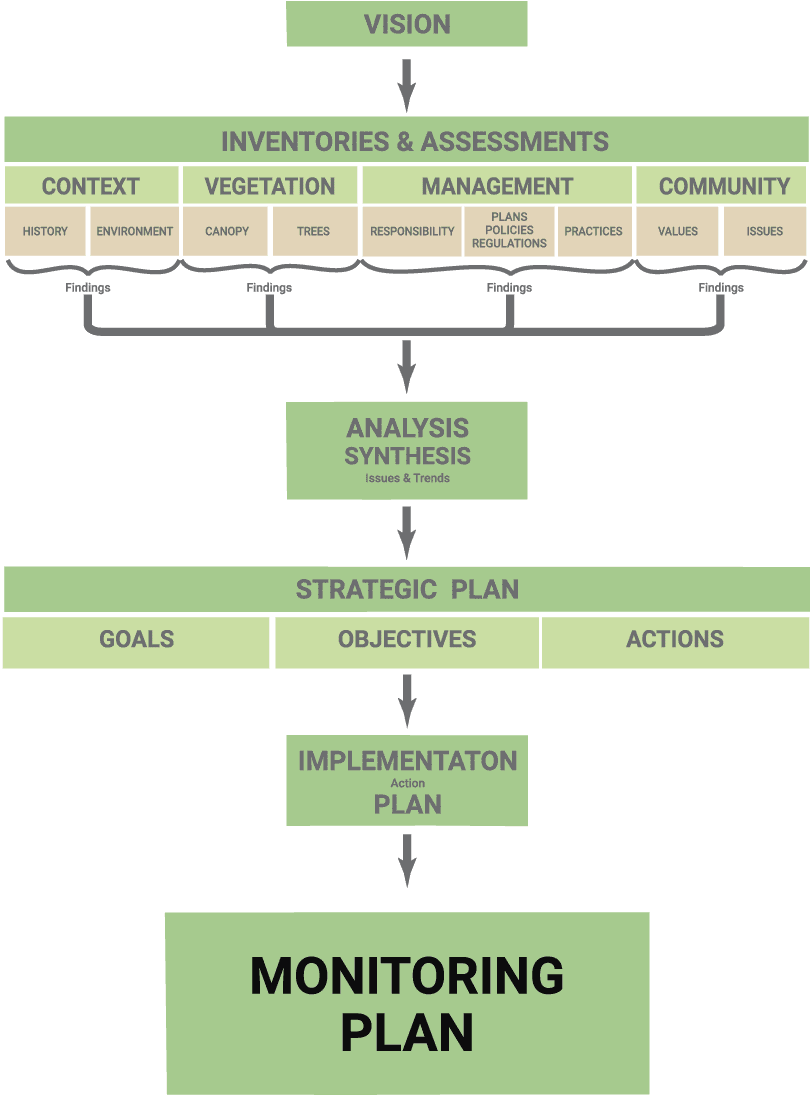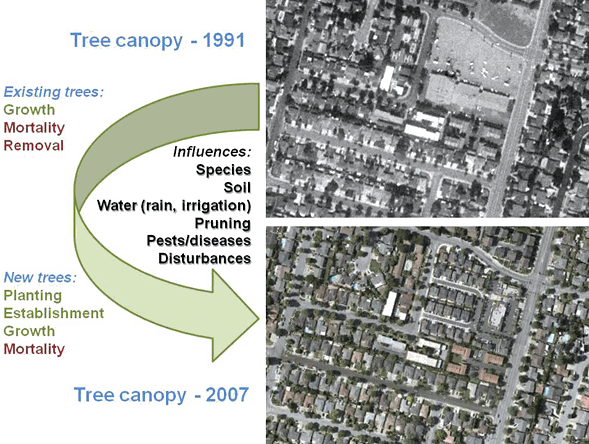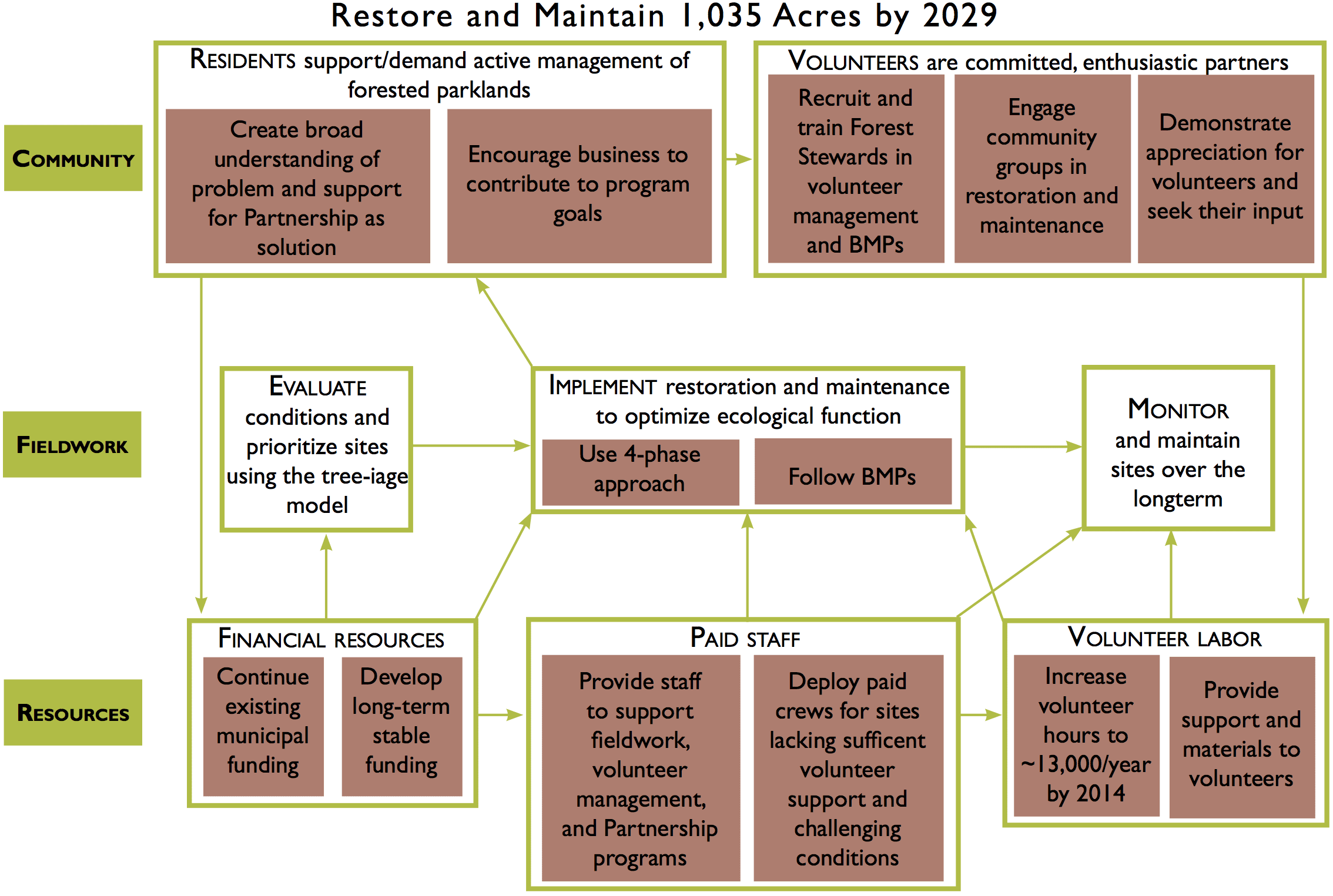
Monitoring Plan
The goal of the monitoring plan is to provide the data needed to understand what is happening, why it is happening, and how specific management adjustments will change the outcome. The possible situations that may arise over the course of a 20-year plan period cannot all be accounted for in the plan. Actions and plans will need to be adjusted over time. By monitoring the urban forest system, information can be gathered to make these adjustments (adaptive management).
Monitoring is designed to measure progress towards the Strategic Plan’s goals. When you start to implement your Strategic Plan to manage the urban forest, you should also start to monitor outcomes. As you implement planned actions and assess results, you will be able to see if progress is being made. You will assess if standards are being met. This feedback tells you how well the various parts of the Strategic Plan are working.
The type of monitoring plan you develop will depend on factors such as scope, size of area, and costs. If your available resources limit the scope of monitoring, you may need to set priorities and focus monitoring on the highest priority areas.
The overall scope of the monitoring activities is defined including what will be monitored, when the data will be collected, how the monitoring data will be gathered and analyzed, and who will collect, analyze, and use the information.

In the case of a small site, the monitoring plan might simply be the expansion of the Implementation Matrix with columns for who is responsible for monitoring, when to collect data, and what data to collect.
If you are planning to monitor a metropolis, you may develop an extensive monitoring plan by answering the same types of questions listed under the Work Plan section at the beginning of this website:
What? If you have developed clear quantifiable goals and objectives, your main monitoring targets should be clear.
Which trees or program activities need to be monitored?
What additional factors need to be monitored?
Will you be monitoring the entire population or a sample?
When?
Will data be collected continuously (e.g., inventory updated by work records) or at specific intervals?
Do some data need to be collected in a specific season or time of year?
How frequently will you do data summary and analysis?
When to collect and analyze the data?
Who?
Who will collect, analyze, and use the information?
How much staff, consultant, and volunteer time will be needed?
How?
How will you gather and analyze the monitoring data?
Are you already collecting the data you need (e.g., in your tree inventory)?
Will you need to initiate additional sampling or record keeping?
How and where will you store the data (e.g., existing GIS, new databases)?
Where? Define the overall scope of your monitoring activities.
| Objective | Monitoring Plan Actions |
|---|---|
| CE-J.1.2 Objective: Canopy Cover | 1. Urban Forest Manager will conduct an aerial study of the urban canopy every five years. 2. Urban Forest Manager will oversee coordination of three planting and recommendations for increasing the urban tree canopy assessment |
| CE-J.1.3 Objective: Age and Species Diversity | 1. Urban Forest Manager will compare updates inventory data annually to monitor and assess progress toward age and species diversity. 2. Urban Forest Manager will track from inventory data (CE-J-1.1) on the age and species of each tree removed and planted. |
| CE-J.1.4 Objective: Tree-planting Success | 1. Horticulturalist and MAD and Park staff or their designee will spot-check all tree stock at the nursery prior to delivery of city trees for compliance. 2. Horticulturalist and MAD and Park staff or their designee will spot-check all tress planted by in-house staff, contractors, or developers for compliance. 3. Horticulturalist and MAD and Park staff will submit semiannual reports to the Urban Forest Manager that contain the number of trees inspected, number and specimens rejected. 4. Horticulturalist and MAD and Park staff or their designee will spot-check tree planting areas to assess adequacy of soil and physical planting conditions. |
| CE-J.1.5b Objective: Young Tree Maintenance | 1. Inspect young trees every six months, for the first four years after planting. 2. Urban Forest Manager, Horticulturalist, and MAD and Park staff annually review the six-month inspections of young trees. |
| CE-J.1.5c Objective: Adult Tree Maintenance | 1. From tree inventory records kept in CE-J.1.1, Horticulturalist and MAD and Park staff compare projected and actual shade tree pruning and palm trimming each year. 2. Maintain a database on the number of complete tree failures and limb drops, species, approximate age, when last pruned, and the probable cause of failure 3. Urban Forest Manager will meet annually with the Horticulturalist and MAD and Park staff to determine if the current tree-pruning program is reducing the number of failures. |
| CE-J.1.5g Objective: Heritage Tree Maintenance | 1. Urban Forest Manager will track identified Heritage Trees for health and safety by inspecting periodically and recording work done on those trees. |
The point of monitoring is to provide the information you need to adjust your management methods and tactics in real time ([itg-glossary glossary-id=”209″]adaptive management[/itg-glossary] ). This allows you to stay on track toward achieving your plan’s objectives.
For example, a city may establish a program to use citizen volunteers to train (prune) newly planted street trees. Close monitoring of the program will be needed to see that pruning standards are being followed and that enough volunteers are available to do the necessary pruning. It may be necessary to revise training methods for volunteers, change volunteer recruitment tactics, or alter other parts of the program to make sure it stays on track. If the volunteer component isn’t completely successful, additional pruning may be needed to be done by staff or contractors, and the Strategic Plan will need to be revised at some point (adaptive management).
Evaluation, revision of the plan, and public review can also help keep stakeholders aware of the urban forest program. To help build and maintain support for the urban forest program, stakeholders and decision makers need to be kept aware of the program’s successes and challenges. Your stakeholders (management, the public, elected officials, etc.) need to be made aware that urban forest management is an ongoing process. Conditions can change.
The aerial photos below show change in canopy cover over time. Both existing trees and new trees contribute to canopy cover. A variety of factors can affect how these trees grow and survive, leading to changes in canopy over time. Monitoring information can indicate which if these factors were most important for changes seen over the entire site or specific parts of it.

| OBJECTIVE | MEASURE | |
| Restore and maintain 1,035 acres of forested parkland by 2029. | Number of acres restored to annual goal | |
| Fieldwork: All 1,035 acres are restored by 2029 | ||
| Evaluate | Evaluate conditions and prioritize sites for restoration | Number sites evaluated, prioritized |
| Plan | Develop an annual work plan | Annual work plan identifying active management sites completed |
| Implement | Implement management projects optimizing ecological function | Number of site management plans completed Number of acres entered into active management Best practices updated annually |
| Monitor | Monitor and maintain sites over the long term | Annual monitoring report Maintenance performed as indicated |
| Community: An informed, involved, and active civic community supports the Green Redmond Partnership. | ||
| Community | Educate and engage community about problem and solution through Green Redmond Partnership | Outreach and education program materials developed |
| Community supports and demands active management of forested parklands through widespread understanding of the issue and support of Green Redmond Partnership as solution | Percent of residents volunteering each year Number of return volunteers |
|
| Volunteers | Engage youth and community organizations in management and monitoring | Number of groups participating in events Number of hours contributed |
| Encourage businesses to contribute to program goals | Number of businesses supporting program through sponsorship, in-kind contributions, or volunteer events Number of businesses that stop selling invasive plants |
|
| Train Forest Stewards in volunteer management and BMPs | Number of Forest Stewards trained and actively holding events | |
| Demonstrate appreciation for volunteers and seek input into program | Number of volunteer suggestions implemented Number of volunteer recognition activities |
|
| Resources: Sufficient resources are available to actively manage sites and provide long-term maintenance. | ||
| Financial | Continue current funding | Amount budgeted and sourced to meet management requirements |
| Develop long-term, stable public funding source | Mechanisms in place by 2014 sufficient to meet need | |
| Paid Staff and Labor | Provide sufficient staff to support field work, volunteer management, and Partnership programs | Number of staff/crew dedicated Number of acres entered into restoration by staff/crew |
| Hire paid crews for priority sites lacking volunteer support or sites with difficult conditions | Percent of priority sites in annual plan not being restored by volunteer efforts entered into restoration Percent of contract crews trained in BMPs |
|
| Volunteer Labor | Increase number of volunteer hours to 14,000 per year by 2015 and 24,000 by 2018 | Number of hours to annual goal, value contribution of volunteer (staff cost per volunteer hour) |
| Increase productivity by providing support and materials to volunteers | Amount and hours/acre enrolled Staff cost per volunteer hour |
|

Reprinted from Green Redmond Partnership’s 20-Year Forest Management Plan, April 2009.
0 Comments